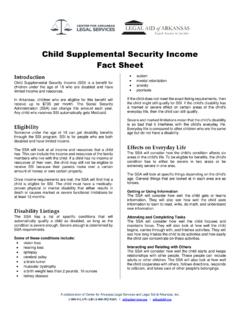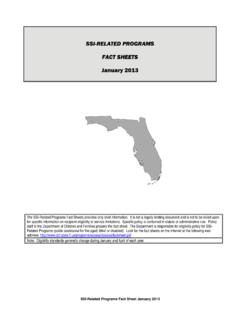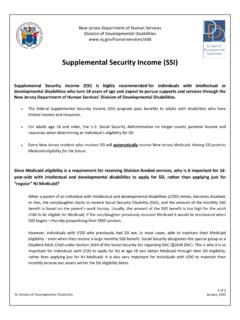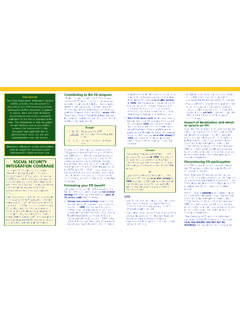Transcription of Wage Reporting Fact Sheet for SSA Disability Beneficiaries
1 Wage Reporting fact Sheet for SSA Disability Beneficiaries If you are a social security Disability beneficiary receiving Supplemental security Income (SSI). and/or social security Disability Insurance (SSDI), and you have returned to work, you are required to report your wages on a monthly basis. Here is what you should know about wage Reporting . Wage Reporting Basics When you start a new job you must inform the social security Administration - they will not automatically know. The best method for informing SSA is to immediately submit a letter to your local SSA Field Office to advise SSA that you have started a new job.
2 The letter should include the following information: 1. Your name and social security Number (SSN), 2. Name of employer, 3. Number of hours you work each week, 4. Hourly rate, and 5. Start date. When you experience increases or decreases in hours or pay, report the change to your local SSA Field Office as soon as possible. To report the increase or decrease in pay, submit a letter with the information noted above to the local SSA Field Office. When a job ends, report the loss of employment to your local SSA Field Office as soon as possible.
3 To report the loss of employment, submit a letter with the information noted above to the local SSA Field Office. To find your nearest SSA Field Office, visit: When and How to Report Wages You should report wages to the local SSA Field Office each month. For most SSA Disability Beneficiaries , the preferred method of Reporting is by mail, or in person at your local Field Office. Here are some tips for Reporting : 1. Make a copy of your pay check stubs to be submitted to SSA. File your original pay check stubs for your records.
4 2. Write your social security Number on the pay check stubs you are submitting to SSA. 3. If you report your wages in person, ask for a receipt from your local Field Office that confirms you have provided evidence of your earnings, and retain this in your records. 4. If you report your pay check stubs by mail, include a letter that asks SSA to send you a receipt from your local Field Office that confirms you have provided evidence of your earnings, and retain this in your records. Be sure to report all monthly wages each month.
5 If you have more than one job, make sure you include pay check stubs from all jobs. Timely Reporting is very important! It is the best way to prevent potential overpayments. For certain SSI recipients, telephone wage Reporting is an option. If you'd like to learn more about this option, visit: How Wages Are Counted For SSI Recipients SSI payments are received on the 1st of each month for that month, causing fluctuations in the amount of payment received from month to month. SSA estimates the amount received based on known circumstances from previous months ( patterns of earnings), SSA calls this Retrospective Monthly Accounting.
6 To determine the SSI benefit payment amount, SSA. considers the following two elements: 1. Computation Month - Based on the individual's (or couple's) income, resources and other factors in the month the SSI benefit payment will be received; and 2. Budget Month A payment computation generally based on the income from two months prior to the month SSI benefit payment will be received. Because of this accounting method, SSA needs earnings information as soon as it's available so they can use that information to adjust payments moving forward.
7 If an SSI recipient is eligible for some or all of their benefit in the budget month and receives wages in their computation month, SSA adjusts the benefit accordingly. Therefore, timely Reporting is especially important for SSI recipients. For SSDI Beneficiaries SSDI Beneficiaries do not have fluctuating benefit amounts, however, it is equally important to report new work activity, changes in employment, and monthly earnings. SSA uses wage information to determine whether or not the SSDI beneficiary is eligible for their SSDI benefit and/or is using available SSDI Work Incentives.
8 Timely Reporting is equally important for SSDI. Beneficiaries .









